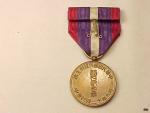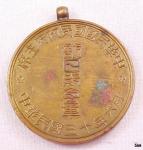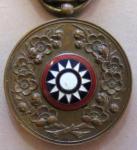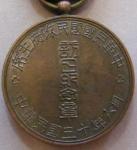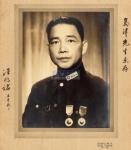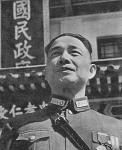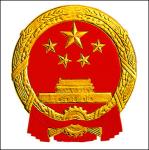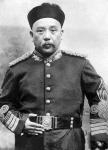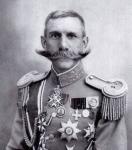-
Posts
851 -
Joined
-
Last visited
-
Days Won
3
Content Type
Profiles
Forums
Blogs
Gallery
Events
Store
Everything posted by drclaw
-
Very interesting Nick! Peterson suggested that the ribbon was made in Japan. Looking at the original cased example, do you reckon the whole award was made in Japan? The quality is much better than the typical Chinese-made Nanjing Puppet awards and the case is similar to Japanese awards.
-
I've been reading through James Peterson's unpublished notes previously posted by Richard. In addition to the Order of United or Common Glory, Peterson also mentions the Order of the Brilliant Jade as the 2nd highest ranking Nanjing Puppet Government order. Has anyone seen an example of this? "Order of the Brilliant Jade Tsai-Yu-Hsun-Chang. It appears that this order, which was established 2 December 1933 by Nationalist China, was adopted and awarded by Wang Ching-Wei’s regime, and probably for this reason seems to have been suspended after 1943 by the Nationalists. According to a Japanese encyclopedia it was the 2nd ranking order, to Chinese only with classes to foreigners without class and different ribbons; in 9 classes, the 1st class with red and white ribbon, 2nd class white and red, 3rd class blue, 4th class red, white and blue, 5th class white, red and blue, 6th class red, white and blue, 7th class blue and red, 8th class light red, and 9th class the Military Order Pao-Ting." (James Peterson) Note: In an article in the Journal of the Orders and Medals Society of America on the Nationalist China Order of the Brilliant Jade, Peterson writes that there was a Grand Cordon Order of the Brilliant Jade (Cai Yu Da Xun Zhang) and a 9-class Order of the Brilliant Jade (Cai Yu Xun Zhang). The latter ceased to be awarded after 1943. According to the President of Taiwan's website, the Order of the Brilliant Jade with Grand Cordon was instituted in 1933 and is the highest order presented by the Republic of China, and can be worn only by the head of a nation.
-
-
http://gmic.co.uk/uploads/monthly_04_2013/post-11630-0-85198100-1365721069.jpghttp://gmic.co.uk/uploads/monthly_04_2013/post-11630-0-88930100-1365721081.jpghttp://gmic.co.uk/uploads/monthly_04_2013/post-11630-0-17487200-1365721104.jpg
-
Another rare award is the 1942 Visit to Japan Commemoration Medal. James Peterson's notes (thanks Richard): "A medal which was probably awarded by the government is about 50mm of dark bronze, with on the obverse a blue and white Enameled Kuomintang sun encircled by two sprays of flowers. The reverse has an inscription. The ribbon which was made made in Japan, is 37mm watered of equal purple/white/red/white/purple.” THREE of these rare medals were sold on ebay / Yahoo Japan Auctions last year within a short space of each other. Images are from ebay / Yahoo Japan Auctions. One of the medals came with three spare ribbons! By way of interest, they sold for more than US 2500 ... A description by one of the vendors: "Visit to Japan Commemoration Medal 1942 Bronze medal 3cm in diameter, 3mm thick. Ribbon, faded, 3.7 cm. Included are three swatches of new ribbon. Hook missing from suspension on reverse of ribbon." http://gmic.co.uk/uploads/monthly_04_2013/post-11630-0-73613000-1365720934.jpghttp://gmic.co.uk/uploads/monthly_04_2013/post-11630-0-67979500-1365720946.jpg http://gmic.co.uk/uploads/monthly_04_2013/post-11630-0-86218000-1365720961.jpghttp://gmic.co.uk/uploads/monthly_04_2013/post-11630-0-54473300-1365720989.jpg
-
Now an example. This is an image from Li Gongqing's website which I hope he won't mind us sharing here. His website China Medal Blog is an excellent resource on Chinese medals. His latest book will be published this year and will include medals for the Nanjing Puppet and Manchukuo governments as well as others. http://chinesemedal.wordpress.com I have his first book on Chinese Orders and it is a superb visual reference catalogue. Obverse and reverse http://gmic.co.uk/uploads/monthly_04_2013/post-11630-0-90288200-1365719883.jpghttp://gmic.co.uk/uploads/monthly_04_2013/post-11630-0-36087300-1365720320.jpg
-
Richard has previously posted some notes by James Peterson, which I will repost here. Peterson describes it as being awarded in two classes. This is confirmed by the first photo of Wang Jingwei above where here is wearing two virtually identical medals. The medal's name in Mandarin is: Hépíng Jiànguó Jìniàn Zhāng. "Peaceful National Foundation Commemoration Medal These very rare medals should also probably be attributed to Wang Ching-Wei’s government. The medal is approximately 36mm silver, circular with an ornamental figure on each of the four sides and in the center a monogram of four characters on a blue medallion which is encircled by a silver wreath and an ornamental border. The ribbon is about 36mm of red plush silk with a blue and white Kuomintang sun on a blue circle in the center. At the top of the ribbon is a silver clasp with seal characters “Peaceful National Foundation Commemorative”. A lower class is in silver and gilt without enamel on a plain red, plush ribbon with the same clasp." (James Peterson)
-
This is a medal that has intrigued me for some time. Thanks to JCwaters and Richard LaTondre for information on a very rare and interesting medal. Photographs of Wang Jingwei as head of the Reorganised Government sometimes show him wearing these decorations. The first is an original signed photo that was sold last year by Huachen Auctions in China. This clearly depicts two such medals. http://gmic.co.uk/uploads/monthly_04_2013/post-11630-0-70816400-1365719178.jpghttp://gmic.co.uk/uploads/monthly_04_2013/post-11630-0-27000400-1365719230.jpghttp://gmic.co.uk/uploads/monthly_04_2013/post-11630-0-94564400-1365719273.jpg
-
I'd agree, Nick. The obverse is very attractive. They are really making some obscure decorations now and have moved on from those ghastly warlord personality medals with their dead staring eyes.
-
It could well depend on the particular badge. We've all seen the very obvious fake / reproduction Striped Tigers, Golden Grains, Double Dragons, etc, selling for $60-$80 on ebay and presumably for much less to tourists in the Beijing markets. As for the medals awarded to everyday people, a couple of years ago, I wandered into this old, dusty book store in Singapore which sold Chinese propaganda posters. They had both modern reproductions as well as gorgeous, 30+ year old originals. I picked up an original. Later, I discovered in a book on Chinese Communist propaganda posters that they literally printed millions if not hundreds of millions of these and every household would have a couple displayed. There are some business-minded folks who now scour towns and villages for these posters to sell to the West and hip, urban Chinese.
-
Thanks for sharing these wonderful images Pieter. I'll post them here. Your grandfather appears to be wearing the neck badge of a European Order in the shape of a cross in the photograph. I'm not sure which decoration it is. The colours of the dragon robe are so rich and vibrant it could have been woven yesterday. You wouldn't imagine it is more than a century old. Your grandfather was definitely a mandarin as a civil servant. He is not wearing his square embroidered cloth rank badge but the round button on his hat certainly denotes mandarin rank as does the five-clawed Imperial dragon. The colour of the round hat button would have identified your grandfather's rank. These were from First to Ninth Rank: ruby, coral, sapphire, lapis lazuli, rock crystal (quartz), tridacna (white shell), gold, gold with incised inscriptions, gold with relief inscriptions.
-
What an interesting story Pieter! Your grandfather had a fascinating life and served under Qing, the early Republic, the Nationalists and the Communists. I particular liked the part where he did not flee to Chongqing like the rest of the Nationalist government but elected to remain in Beijing to do what he could. Would you mind sending me a high quality image of your grandfather in Imperial robes and the Double Dragon to gavgoh88(at)yahoo.com.au? Would love to include it in the 2nd edition of my book together with your grandfather's story if and when I ever publish it. We don't know your grandfather's name. Also, what was the bird embroidered on the chest square of his Qing robe? The different mandarin ranks were distinguished by different birds for civil officials (animals for military officials). From the First (highest) to the Ninth (lowest) rank, these were: Manchurian crane, golden pheasant, peacock, wild goose, silver pheasant, egret, mandarin duck, quail and paradise flycatcher.
-
-
Fantastic! I love the embroidered Golden Wheat motif on his dress uniform. Interestingly, while grain was a traditional symbol of abundance the choice of wheat reflected the Northern bias of the Beiyang warlords. Rice was the staple grain for the south and for most of the warlord period, the country suffered the traditional division between north and south. The national emblem of the People's Republic of China also features grain to represent agriculture and peasants / farmers. But unlike the early Republic, both wheat AND rice are depicted.
-
Thanks Nick! My favourite would be the Double Dragon in #74, next to the star of the St Stanislaus?
-
Pieter, looking forward to the photo of your grandfather. He would have been a recipient of some very nice Nationalist decorations I'd imagine. Does your family still have these? Would love to hear about your grandfather's story. My paternal grandfather was a British civil servant in Singapore when the Japanese invaded in 1941. He was rounded up during the Sook Ching massacre when the Japanese were executing anyone who worked for the British, had a tattoo (gang member) or wore spectacles. He leapt over the fence and escaped while the others were never seen again. He received the UK Defence Medal after the war. But unfortunately I didn't ask him about the circumstances of the award before he passed on. Cheers, Gavin
-
Very nice, gents. These are simply beautiful and true works of art. Congrats! Yes, that blue/green ribbon in the document is quite different to the actual shade. Were there ever examples awarded in that colour?
-
I've always envied the Japanese ability to grow impressive facial hair. As a Chinese, the most I could aspire to is a few thin wispy strands by the age of 90. A disposable razor lasts six months ...
-
For interest, here is the "Old" and "New" uniforms as modelled by Yuan Shikai. The first is as a Qing general - understated and elegant in my personal view. The second is in the bling new uniform designed by Munthe. The top breast star is that of the Great Merit Order (Da Xun Zhang, aka the Grand Order). This was founded by Yuan as the Republic's highest honour. It was virtually identical to the Qing Great Precious Order (Da Bao Zhang) founded the previous year by the last Emperor Puyi, and depicted the Twelve Symbols of Imperial Authority! http://gmic.co.uk/uploads/monthly_03_2013/post-11630-0-26252900-1363421232.jpghttp://gmic.co.uk/uploads/monthly_03_2013/post-11630-0-86927200-1363421255.jpg
-
It is widely known that Munthe designed the uniforms of the Republic's generals. I've also come across tantalising hints that as Yuan Shikai's general aide-de-camp and adviser, he also designed the orders of the new Republic like the Order of the Striped Tiger, the Golden Grain, the White Eagle, etc. I have not been able to find definitive references however. If anyone knows more about Munthe, I'd love to learn. The definitive biography was written by J. Huitfeldt and published in 1990. Unfortunately, I have not been able to locate a copy. It is also in Danish which is one of the (many) languages outside my competence. Gavin
-
Johan Munthe (1864-1935), wearing the dress uniform of a Chinese general that he designed himself. The Norwegian spent almost 50 years in China serving under Sir Robert Hart, the Qing, Yuan Shikai and Chiang Kai-shek. He was a voracious collector of Chinese art which he shipped in crates to a museum in Bergen. Munthe received the Golden Grain Second Class from Yuan and is wearing his friend and patron’s Presidential Inauguration Medal. Among his many decorations were the Order of St Olav, Order of Dannebrog, Legion d'Honneur and the Qing Imperial Order of the Double Dragon (Second Class, Third Grade). He is buried in Beijing.
-
Gents, Chinese orders are my particular interest. I've been researching about an absolutely fascinating chap - Johan Wilhelm Munthe, who was born in Bergen, completed the Norwegian army cavalry school, before sailing to China where he spent the next 50 years of his life. Munthe hitched his star to Yuan Shikai, China's leading strongman of the late Imperial and early Republic era, and rose to the rank of Lieutenant General in the Chinese army. He designed the flamboyant new uniforms of the Republican generals and, I believe, many of the Chinese Republic's new orders which were founded by President Yuan Shikai in 1912, the first year of the Republic. He was the most influential foreigner in China and lived in a Norwegian style house in Beijing with his wife. The following is an abstract of a study I'm currently writing. General Johan Wilhelm Munthe The orders were likely designed by a flamboyant Norwegian adventurer and Yuan Shikai confidant. Johan Wilhelm Munthe was born in Bergen and graduated from the cavalry school in 1886. He sailed for China the following year and joined the Chinese Customs Service under Sir Robert Hart. When war broke out with the Japanese in 1894, Munthe volunteered with the Chinese army. He served as a cavalry instructor under Yuan Shikai and the two became firm friends. During the Boxer Rebellion, Munthe attached himself to the Russian army and was one of the first to enter Beijing with the international relief force. Later, he served as Yuan’s adjutant and rose to the rank of major-general. He returned to Customs after Yuan was forced out by the Prince Regent. When Yuan became President, he promoted his friend to general aide-de-camp and adviser in the Ministry of War with the rank of lieutenant-general. Munthe assumed Sir Robert Hart’s mantle as the most influential foreigner in China. He commanded the elite army regiment protecting the Foreign Legations until his death in 1935. Munthe designed the new military dress of the Republic’s generals that he modelled after the Swedish Royal Guard with their blue uniforms and towering white plumes. It seems Munthe also helped design many of the orders and decorations of the new Republic. In so doing, he followed the path of his one-time superior Sir Robert Hart who designed the Imperial Order of the Double Dragon 30 years earlier.
-

Persia - Order of the Lion and the Sun
drclaw replied to drclaw's topic in Middle East & Arab States
Wow, talk about bling! How much do these go for at auctions Markus? I still can't shake that suspicion that some folks buy diamond encrusted orders to break out the diamonds ...



